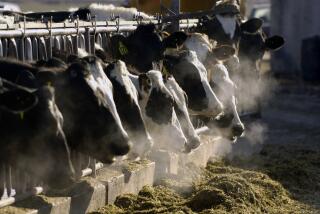
- Share via
- CDC report shows H5N1 infection in veterinarians who did not know they were working with infected cattle
- The veterinarians had no symptoms but have antibodies in their blood
- One of the veterinarians worked in two states where no known H5N1 infections were reported in cows: South Carolina and Georgia
A new study published by the U.S. Centers for Disease Control and Prevention shows that the H5N1 bird flu virus is likely circulating undetected in livestock in many parts of the country and may be infecting unaware veterinarians.
In the health agency’s Morbidity and Mortality Weekly Report, a group of researchers from the CDC, the Ohio Department of Health and the American Assn. of Bovine Practitioners, reported the results of an analysis they conducted on 150 bovine, or cow, veterinarians from 46 states and Canada.
They found that three of them had antibodies for the H5N1 bird flu virus in their blood. However, none of the infected vets recalled having any symptoms — including conjunctivitis, or pink eye, the most commonly reported symptom in human cases.
The three vets also reported to investigators that they had not worked with cattle or poultry known to be infected with the virus. In one case, a vet reported only having practiced in Georgia (on dairy cows) and South Carolina (on poultry) — two states that have not reported H5N1 infections in dairy cows.
Seema Lakdawala, a microbiologist at Emory University in Atlanta — who was not involved in the research — said she was surprised that only 2% of the veterinarians surveyed tested positive for the antibodies, considering another CDC study showed that 17% of dairy workers sampled had been infected. But she said she was even more surprised that none of them had known they were infected, nor did they know they had worked with infected animals.
“These surprising results indicate that serum surveillance studies are important to inform risk of infections that are going undiagnosed,” she said. “Veterinarians are on the front line of the outbreak, and increased biosafety practices like respiratory and eye protection should reduce their exposure risk.”
Jennifer Nuzzo, director of the Pandemic Center at Brown University, described the study as a “good and bad news story.”
“On one hand, we see concerning evidence that there may be more H5N1 outbreaks on farms than are being reported,” she said. “On the other hand, I’m reassured that there isn’t evidence that infections among vets have been widespread. This means there’s more work that can and should be done to prevent the virus from spreading to more farms and sickening workers.”
The analysis was conducted in September 2024. At that time, there had only been four human cases reported, and the infection was believed to be restricted to dairy cattle in 14 states. Since then, 68 people have been infected — 40 working with infected dairy cows — and the virus is reported have infected herds in 16 states.
John Korslund, a retired U.S. Department of Agriculture scientist, said in an email that finding H5N1 antibodies in the blood of veterinarians was an interesting “but very imprecise way to measure state cattle incidence.” But it underscored “that humans ARE susceptible to subclinical infections and possible reassortment risks, which we already knew, I guess.”
Reassortment occurs when a person or animal is infected with more than one influenza virus, allowing the two to mingle and exchange “hardware,” potentially creating a new, more virulent strain.
More importantly, he said, the D1.1 version of the strain — which has been detected in Nevada dairy cattle and one person living in the state — is “changing the landscape .... [P]eople may be more more susceptible (or not) with a greater potential for severeness (or not).”
“I’m confident that we’ll find it in other states. Its behavior and transmissibility within and between cattle herds is still pretty much a black box,” he said.







